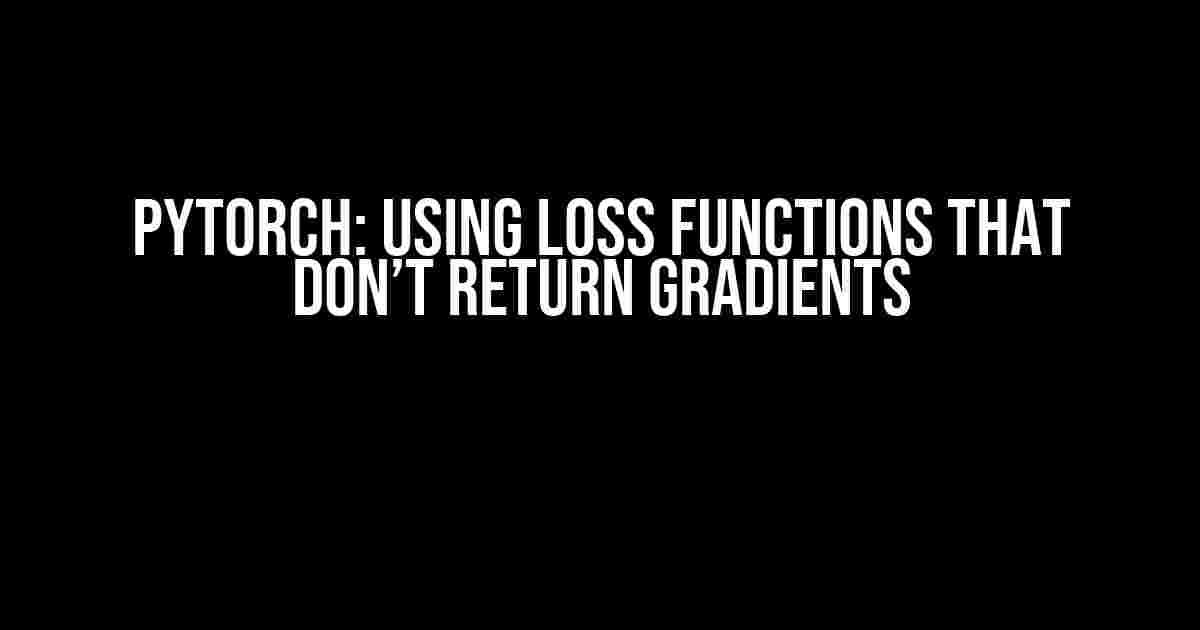Are you tired of dealing with loss functions that return gradients in PyTorch? Do you want to simplify your model’s architecture and focus on the essential parts of your deep learning project? Look no further! In this article, we’ll dive into the world of PyTorch and explore how to use loss functions that don’t return gradients.
What are Loss Functions?
A loss function, also known as an objective function, is a mathematical function that measures the difference between the model’s predictions and the actual output. The goal of training a neural network is to minimize the loss function by adjusting the model’s parameters. In PyTorch, loss functions are used to calculate the error between the model’s output and the target output.
Why Do Loss Functions Return Gradients?
In PyTorch, loss functions typically return gradients because gradients are necessary for backpropagation. Backpropagation is an optimization algorithm used to update the model’s parameters based on the error between the predicted output and the actual output. Gradients are used to compute the error gradient of the loss function with respect to the model’s parameters, which is essential for updating the parameters during training.
When to Use Loss Functions that Don’t Return Gradients?
There are scenarios where using loss functions that don’t return gradients can be beneficial:
- Simplified Model Architecture: By not returning gradients, you can simplify your model’s architecture and focus on the essential components.
- Faster Training: Since gradients are not computed, training time can be significantly reduced.
- Reduced Memory Usage: Not storing gradients can reduce memory usage, especially for large models.
How to Use Loss Functions that Don’t Return Gradients in PyTorch?
To use loss functions that don’t return gradients in PyTorch, you need to wrap your loss function with the `torch.no_grad()` context manager. This tells PyTorch not to compute gradients for the loss function.
import torch
import torch.nn as nn
import torch.optim as optim
# Define a simple neural network
class Net(nn.Module):
def __init__(self):
super(Net, self).__init__()
self.fc1 = nn.Linear(1, 1)
def forward(self, x):
return self.fc1(x)
net = Net()
# Define a loss function that doesn't return gradients
def custom_loss(output, target):
with torch.no_grad():
loss = (output - target) ** 2
return loss
# Create an optimizer
criterion = custom_loss
optimizer = optim.SGD(net.parameters(), lr=0.01)
# Train the network
for epoch in range(100):
output = net(torch.randn(1, 1))
loss = criterion(output, torch.randn(1, 1))
optimizer.zero_grad()
loss.backward()
optimizer.step()
Understanding the `torch.no_grad()` Context Manager
The `torch.no_grad()` context manager is a powerful tool in PyTorch that allows you to disable gradient calculation for a specific block of code. When you wrap a piece of code with `torch.no_grad()`, PyTorch will not compute gradients for the operations within that block.
with torch.no_grad():
# Code inside this block will not compute gradients
x = torch.randn(1, 1)
y = x ** 2
Common Use Cases for Loss Functions that Don’t Return Gradients
Here are some common scenarios where using loss functions that don’t return gradients can be beneficial:
- evaulation metrics: When computing evaluation metrics such as accuracy, precision, or recall, you don’t need to compute gradients. Wrapping your metric calculation with `torch.no_grad()` can simplify your code and improve performance.
- Custom Loss Functions: If you have a custom loss function that doesn’t require gradients, you can use `torch.no_grad()` to disable gradient calculation.
- Non-Differentiable Loss Functions: Some loss functions, such as the Huber loss or the Mean Absolute Error (MAE), are not differentiable. In such cases, using `torch.no_grad()` can help you avoid gradient computation.
Conclusion
In this article, we explored the world of loss functions in PyTorch and learned how to use loss functions that don’t return gradients. By understanding when to use loss functions that don’t return gradients and how to implement them using `torch.no_grad()`, you can simplify your model’s architecture, reduce memory usage, and improve training speed.
Frequently Asked Questions
Here are some frequently asked questions about using loss functions that don’t return gradients in PyTorch:
| Question | Answer |
|---|---|
| Will using loss functions that don’t return gradients affect my model’s performance? | No, using loss functions that don’t return gradients will not affect your model’s performance. However, it may affect the training process and the optimization algorithm used. |
| Can I use loss functions that don’t return gradients with any optimizer? | No, not all optimizers support loss functions that don’t return gradients. Some optimizers, such as SGD, require gradients to update the model’s parameters. |
| How do I know if my loss function requires gradients? | You can check the documentation for your specific loss function or consult with the PyTorch documentation. If the loss function is differentiable, it will typically return gradients. |
We hope this article has provided you with a comprehensive understanding of using loss functions that don’t return gradients in PyTorch. Remember to use `torch.no_grad()` wisely and only when necessary to avoid affecting your model’s performance.
Further Reading
If you’re interested in learning more about PyTorch and deep learning, we recommend checking out the following resources:
- PyTorch Documentation
- Deep Learning Book by Ian Goodfellow, Yoshua Bengio, and Aaron Courville
- TensorFlow Documentation
Frequently Asked Question
Get ready to dive into the world of PyTorch and uncover the secrets of using losses that don’t return gradients!
Why do some losses in PyTorch not return gradients?
Some losses in PyTorch, like torch.nn.CrossEntropyLoss(), only compute the loss value and don’t compute the gradients. This is because they’re designed to be used as an evaluation metric, rather than as a training objective. You can still use them as a training objective, but you’ll need to explicitly create a gradient tensor and accumulate gradients manually.
How do I create a custom loss function that doesn’t return gradients in PyTorch?
To create a custom loss function that doesn’t return gradients, you can define a PyTorch nn.Module that computes the loss value, but doesn’t register the gradients. For example, you can use the @torch.no_grad() decorator to prevent gradient computation. Just be aware that you’ll need to handle the gradient computation manually if you want to use this loss for training.
Can I use a loss function that doesn’t return gradients for training a PyTorch model?
Technically, yes, you can use a loss function that doesn’t return gradients for training a PyTorch model. However, you’ll need to manually create and accumulate gradients using PyTorch’s tensor manipulation APIs. This can be error-prone and may lead to incorrect gradient computations. Instead, consider using a loss function that returns gradients or use a higher-level API like PyTorch’s nn.CrossEntropyLoss()
What’s the difference between a loss function that returns gradients and one that doesn’t?
A loss function that returns gradients computes both the loss value and the gradients of the loss with respect to the model’s parameters. This is useful for training a model, as the gradients are used to update the model’s parameters. A loss function that doesn’t return gradients only computes the loss value, which is useful for evaluation or monitoring the model’s performance.
Are there any benefits to using a loss function that doesn’t return gradients?
Yes, there are benefits to using a loss function that doesn’t return gradients. For example, it can be more memory-efficient, especially when working with large models or large batches. Additionally, it can be useful for evaluating the model’s performance on a validation set, as it allows you to compute the loss without affecting the model’s gradients.


